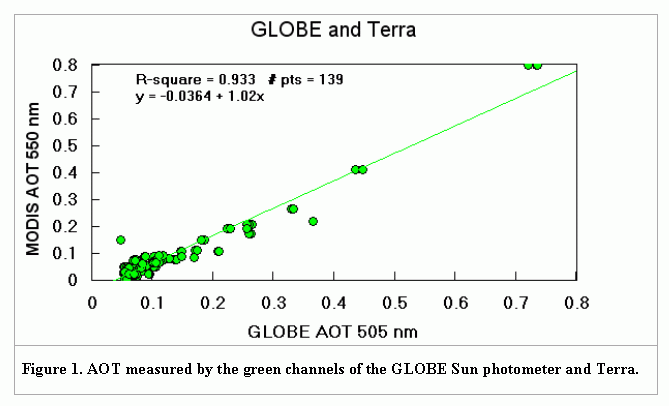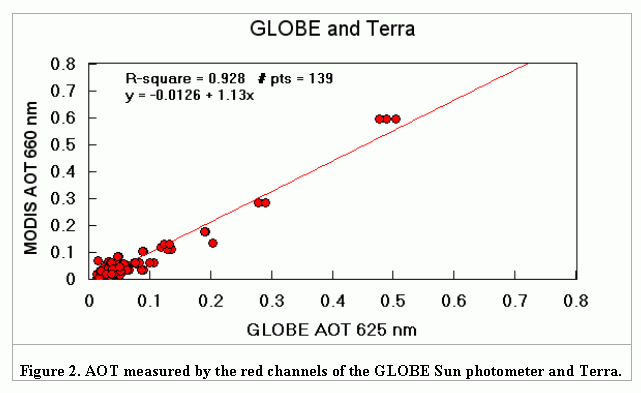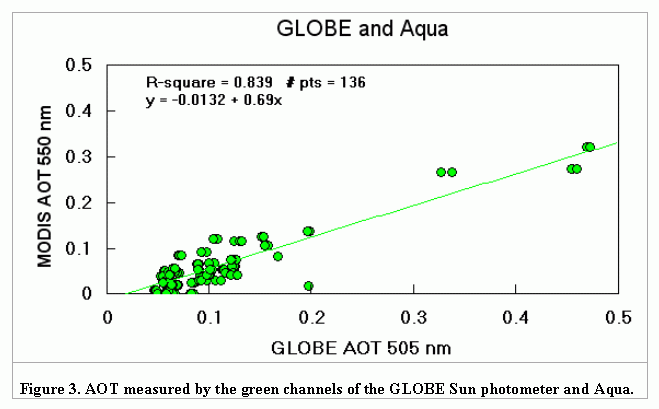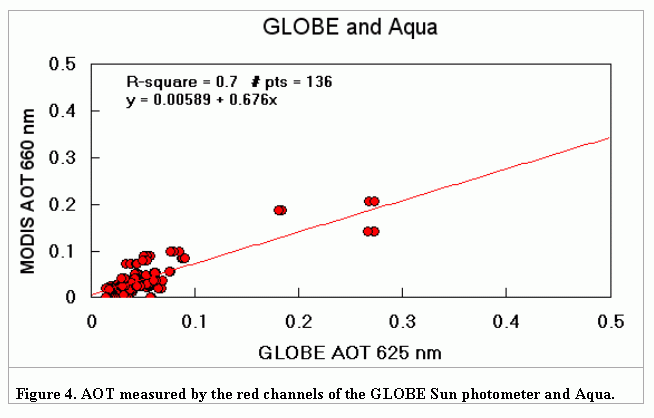

David R. Brooks
Drexel University
Room 173 Randell
3141 Chestnut Street
Philadelphia, PA 19104 USA
E-Mail:brooksdr@Drexel.edu
URL:
http://www.pages.drexel.edu/~brooksdr/DRB_web_page/
Two years of measurements of aerosol optical thickness (AOT) by a GLOBE Sun photometer agree well with nearly simultaneous (within +/-5 minutes) measurements of AOT from space by the MODIS instrument on NASA's Terra and Aqua satellites. A pilot comparison with Terra was conducted from September 2001 to March 2002. This comparison yielded a remarkably high correlation coefficient when the ground measurements were made within 10 minutes of the satellite's peak overpass (r2 > 0.99 for both the 505 nm and 625 nm GLOBE channels). This finding led to a 2-year comparison of the same GLOBE Sun photometer with the green (550 nm) and red (660 nm) channels of Terra and Aqua. From March 2002 to May 2004, more than 420 comparisons during more than 140 separate overpasses were conducted within 0 to 10 minutes of the peak overpass time of Terra and Aqua. Comparisons were conducted only when the sky was free or nearly free of clouds. The ozone amount required to correct the data was provided by the TOMS instrument on NASA’s EarthProbe satellite. Measurements made by the Sun photometer within 5 minutes of 48 Terra morning overpasses are very well correlated with MODIS (r2 = 0.97 for the 505 nm GLOBE channel and r2 = 0.96 for the 625 nm GLOBE channel). Measurements made by the Sun photometer within 5 minutes of 46 Aqua afternoon overpasses are moderately correlated with MODIS (r2 = 0.84 for the 505 nm GLOBE channel and r2 = 0.70 for the 625 GLOBE channel). These results demonstrate that GLOBE students can perform validation studies of MODIS or use MODIS to check the calibration of their Sun photometers.
The GLOBE haze protocol is designed to permit students to perform short- and/or long-term measurements of aerosol optical thickness (AOT) using the GLOBE Sun photometer. Because of the limited number of ground stations that make AOT observations, carefully made AOT measurements by portable Sun photometers have important scientific use. For example, during a study of biomass burning aerosols in Zambia in 2000, the U.S. Forest Service, the Goddard Space Flight Center and some 20 local school teachers collaborated on measurements of AOT using LED Sun photometer based on the GLOBE design (Eck et al., 2002). A similar collaboration using 35-handheld Sun photometers took place in Brazil in 2003 (Hao et al., 2003).
The GLOBE Sun photometer is based on a non-standard design that uses light-emitting diodes (LEDs) as spectrally selective light sensors, rather than traditional photodiodes and interference filters (Mims, 1991). Therefore, for these measurements to be seriously considered by the scientific community, it is essential that the instrument be carefully compared against
conventional instruments that measure AOT. A 2.5-year time series of comparisons with filter and LED versions of Microtops, a commercial Sun photometer, has been conducted at Geronimo Creek Observatory in South Texas and during calibration sessions at Mauna Loa Observatory, Hawaii. Results of this comparison are now being evaluated. This paper describes clear-sky observations during this comparison that were intentionally made during overpasses by the MODIS (Moderate Resolution Imaging Radiometer) instrument aboard NASA’s Terra and Aqua satellites.
The GLOBE Sun photometer has two channels with, respectively, peak spectral responses of 505 nm in the green and 625 nm in the red. These wavelengths are reasonably close to the 550 nm and 660 nm channels of, a satellite instrument that makes reliable measurements of AOT (Mims, 1999, Brooks and Mims, 2001). A key objective of this work was to determine if students can use a simple Sun photometer to validate AOT measurements made by the MODIS instruments on the Terra and Aqua satellites. A parallel objective was to determine if satellite measurements of AOT can be used to check measurements made by students on the ground
The success of a pilot study (see below) led to the decision to undertake a 2-year comparison of the same GLOBE Sun photometer used in the pilot study with Terra and Aqua at the same Geronimo Creek Observatory site. From March 2002 to May 2004, more than 420 comparisons during more than 140 separate overpasses were conducted within 0 to 10 minutes of the optimum overpass time of the Terra and Aqua satellites. Comparisons were conducted only at times when the sky was totally clear or nearly free of clouds. The ozone amount required to correct the data was provided by the TOMS instrument on NASA’s EarthProbe satellite.
Terra is the first in a series of sophisticated remote sensing satellites developed by NASA and its contractors as part of NASA’s Earth Observing System (EOS). MODIS, one of Terra’s main instruments, is a spectroradiometer that scans the Earth below the satellite at 36 wavelengths ranging from the blue to the middle infrared. Data are provided as images or tabulated files.
MODIS is the first instrument specifically designed to measure AOT from space. It does so at specific wavelengths in the blue, green and red by means of algorithms that account for the reflectance of the Earth and the passage of sunlight down through the atmosphere and back into space. Near-infrared channels are used to calculate the total column water vapor.
Terra was launched on December 18, 1999, into a Sun synchronous, polar orbit that places it overhead before noon at least once each day. On May 4, 2002, a second MODIS was successfully launched aboard Aqua, the second EOS satellite. Aqua’s orbit places it overhead after local noon at least once each day. Thus, MODIS measurements from Aqua will permit the monitoring of changes in AOT and water vapor that may have occurred after the pre-noon Terra overpass.
A protocol was developed for a pilot study that required measurements be made within 30 minutes of overpass, the same time used in comparisons of Terra and AERONET Sun photometers (Chu et al., 2002). The protocol is slightly revised from the GLOBE haze protocol (www,globe.gov) to allow for the use of multiple laboratory grade instruments. The results of those comparisons have not yet been determined and will be reported later.
The pilot comparison of Terra green and red AOT observations with a GLOBE Sun photometer was conducted from September 2001 to March 2002 at Geronimo Creek Observatory in South Texas. This comparison yielded a remarkably high correlation coefficient when the ground measurements were made within 10 minutes of the satellite's peak overpass (r2 > 0.99 for both the 505 nm and 625 nm GLOBE channels).
The pilot study showed that the best results occur when the time difference is less than 10 minutes. Therefore, the protocol was revised so that measurements were made as close as possible to the optimum overpass time. Also, comparisons were limited to days with clear or nearly clear skies. Here is the slightly revised protocol that was used for the present 2-year comparison study:
1. Determine the MODIS overpass time using NASA’s Spacecraft Overpass Predictor
http://earthobservatory.nasa.gov/MissionControl/overpass.html. This web-accessible program is simple, and middle school and older students should be able to use it after some simple direction from a teacher or peer. For example, Lanster Martin quickly learned to use this web site and a GPS receiver without supervision when he was an 11-grade student at Seguin High School.
2. Use a GLOBE Sun photometer calibrated by the Langley method at Mauna Loa Observatory to perform ground observations during or as close as possible to the MODIS overpass time.
3. Store the GLOBE instrument in a closed container shielded from direct sunlight until it is used.
This significantly reduces heating that can cause temporary calibration drift.
4. Make and note 3 separate green-red observations within 2 minutes or less.
Record the dark voltage for each channel at the end of the session.
5. Record the time of each measurement using a watch that has been recently calibrated against a GPS receiver or a radio or Internet time signal (e.g., www.time.gov).
6. Measure the ozone column with a well-calibrated MICROTOPS II within a few minutes of each GLOBE Sun photometer session.
Because these measurements agree well with the ozone measured by Earth Probe TOMS, the satellite value was used to more closely simulate the results students will obtain. See
http://toms.gsfc.nasa.gov/index.html. Failing to subtract the optical depth caused by ozone will cause important errors for both the green and red channels of the GLOBE Sun photometers.
7. Record the temperature, barometric pressure, dew point and relative humidity.
8. Record the sky conditions, especially the sky color, presence of clouds, cloud haze, smoke and dust.
Crepuscular rays caused by cloud shadows should be noted, for they provide an important indicator of haze.
9. Photograph the entire sky using a 186-degree full-sky (fisheye) lens.
Photograph the solar aureole while the solar disk is blocked by a small sphere (Mims, 2003).
10. Enter the raw data for each GLOBE Sun photometer measurement into a spreadsheet program that calculates AOT.
Subtract from the AOT the optical depth of the ozone layer to arrive at the final AOT.
11. Retrieve MODIS data from the web when they become available.
Plot the mean AOT for the 550 nm and 660 nm MODIS channels against the AOT for the 505 nm and 625 nm GLOBE channels. Perform linear regressions of the paired data sets for various selections of days to determine the level of agreement. Assess the data and consider deleting outliers only on a case-by-case basis. (No outliers are deleted in the present paper.) Sky photographs and visual observations of the sky that show cloud haze or variable smoke or dust during a MODIS overpass are good cause for eliminating a data point.
This protocol works reasonably well when both MODIS and the ground Sun photometer are making observations during the overpass window. This is not always the case. For various reasons, there are no MODIS data for some days when sky conditions were pristine. On some days when ground measurements were not made during the overpass window due to clouds in the area, MODIS measurements were made anyway. The ground observer does not know in advance if MODIS data for a particular overpass session will be available. During this study, there were periods of months when data were either not available or before data was published on the MODIS web site.
These findings compare well with the results of a comparison of MODIS and some 30 automated CIMEL Sun photometers in the AERONET network (Chu et al., 2002). That study validated blue and red MODIS channels. The correlation for the AERONET and MODIS red channels for the Central United States (Fig. 3(a) in Chu et al., 2002) within 30 minutes of overpass was surprisingly close to the comparison of the GLOBE (pilot study) and MODIS red channels within 35 minutes of GCO, r2 = 0.72 and 0.80, respectively. In this 2-year study, the comparisons within 10 minutes of Terra overpasses were considerably better for GLOBE than comparisons within 30 minutes for AEONET.
Figures 1 and 2 are x-y scatter plots of measurements made by the GLOBE Sun photometer within 5 minutes of 48 Terra clear or nearly clear sky overpasses. Measurements with the GLOBE instrument are very well correlated with MODIS (r2 = 0.97 for the 505 nm GLOBE channel and r2 = 0.96 for the 625 GLOBE channel). However, the slope of the red channel regression line is opposite the finding of Chu et al. (2002). They found that Terra tends to overestimate AOT when compared to the robotic Cimel Sun photometers in the AERONET network. In this study, the green channels of both GLOBE and Terra gave nearly the same AOT, and Terra’s red channel underestimated the AOT, a result influenced by a single session of 3 measurements (Fig. 1).
 |
 |
Figures 3 and 4 are x-y scatter plots of measurements made by the GLOBE Sun photometer within 5 minutes of 46 Aqua overpasses. The slope of the regression line of the red channels is in the same direction but greater than the finding of Chu et al., (2002). The GLOBE data are less well correlated with Aqua than with Terra (r2 = 0.84 for the 505 nm channel and r2 = 0.70 for the 625 channel).
 |
 |
The findings from this 2-year comparison compare favorably with the results of a comparison of MODIS and some 30 automated CIMEL Sun photometers in the AERONET network (Chu et al., 2002). That study validated Terra’s blue and red MODIS channels over various regions (green channel not studied). The correlation of the AERONET and MODIS red channel for the Eastern United States within 30 minutes of overpass was r2 = 0.72 (Terra). The correlation coefficient of the GLOBE and MODIS red channel at GCO was r2 = 0.93 (Terra) and r2 = 0.70 (Aqua).
Because the same GLOBE Sun photometer was used for all the comparisons, we are unsure why the results of the Terra comparison are superior to those of the Aqua comparison. One possibility is the time difference in the comparisons. Terra overpasses occur before noon, and Aqua overpasses occur after noon, when the sky is generally more turbid. This could explain increased scatter in the Aqua comparisons that might not be discernable in satellite observations over a much larger area. This does not explain the difference in the slope between the Terra and Aqua comparisons. We plan to correct the data for the difference in wavelengths between MODIS and the GLOBE sun photometer to determine if this improves the agreement in the slopes. We also plan to expand this study by examining the filter Sun photometer observations that were made using Microtops Sun photometers during most overpass comparisons.
A 2-year comparison of AOT measured by a GLOBE LED Sun photometer and the MODIS instrument in the Terra and Aqua satellites yielded good results. The correlation coefficient of the GLOBE and MODIS green channel was r2 = 0.93 (Terra) and r2 = 0.84 (Aqua). The correlation coefficient of the GLOBE and MODIS red channel was r2 = 0.93 (Terra) and r2 = 0.70 (Aqua). These results compare favorably with a comparison by the Goddard Space Flight Center of the red channel of the Terra MODIS and Cimel robotic Sun photometers in the AERONET network. For AERONET sites in the Eastern U.S., the correlation coefficient with Terra’s red channel within 30 minutes of overpass was r2 = 0.72 (Chu et al., 2002).
These results affirm the original GLOBE pilot study and suggest:
1. A well calibrated, carefully operated LED Sun photometer assembled from parts costing under $70 US can validate AOT measurements made by MODIS.
2. MODIS validation is a feasible project for serious students who can find the time to make careful GLOBE Sun photometer observations within +/- 5 minutes of the MODIS overpass.
3. Under the assumption that the bias of MODIS data over a specific area is known, GLOBE and other scientists can use MODIS observations to validate student measurements of AOT.
Annual calibrations of GLOBE Sun photometers at Mauna Loa Observatory will continue to assess the long-term stability of these inexpensive instruments.
We thank Charles Ichoku of the Goddard Space Flight Center (GSFC) for his rapid responses to data inquiries and other questions. We also thank Brent Holben, Tom Eck, Yoram Kaufman, and Lorraine Remer of (GSFC) for helpful discussions. We are grateful to John Barnes of Mauna Loa Observatory for permission to conduct annual calibrations of GLOBE Sun photometers. Preparation of this paper was sponsored by the GLOBE program. The University of the Nations provided travel expenses to Hawaii and other assistance.
Brooks, D.R. and F. M. Mims III (2001). Development of an inexpensive handheld LED-based Sun photometer for the GLOBE program, J. Geophysical Research 106(D5), 4733-4740.
Chu, D. A., Y. J. Kaufman, C. Ichoku, L. A. Remer, D. Tanre, and B. N Holben (2002). Validation of MODIS aerosol optical depth retrieval over land. Geophyical Research Letters 29, 10.1029/2001 GL013205.
Eck, T. F., B. N. Holben, D. E. Ward, O. Dubovik, J. S. Reid, A. Smirnov, M. M. Mukelabai, N. C. Hsu, N. T. O’Neill, and I. Slutsker (2001). Characterization of the optical properties of biomass burning aerosols in Zambia during the 1997 ZIBBEE Field Campaign, J. Geophysical Research 106, 3425–3448.
Hao, W. M., R. E. Babbitt, B .L. Nordgren, E. N. Lincoln, S. P. Baker, and R. A. Susott, M. Yamasoe, P. Artaxo, B. N. Holben (2003). A comparison of MODIS aerosol optical thickness to handheld sun photometer and AERONET sun photometer measurements during the dry season in the western Amazon Basin, Brazil, 2002, Geophysical Research Abstracts 5, 04515.
Mims III, F.M. (1992). Sun Photometer with Light-Emitting Diodes as Spectrally Selective Detectors, Applied Optics 31, 6965-6967.
Mims III, F.M. (1999). An International Haze-Monitoring Network for Students, Bulletin of the American Meteorological Society 80, 1421-1431.
Mims III, F.M. (2003). Solar aureoles caused by dust, smoke and haze, Applied Optics 42, 492-496.